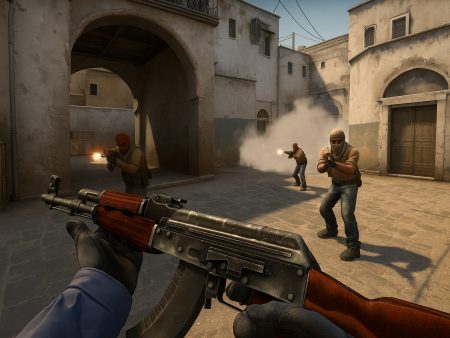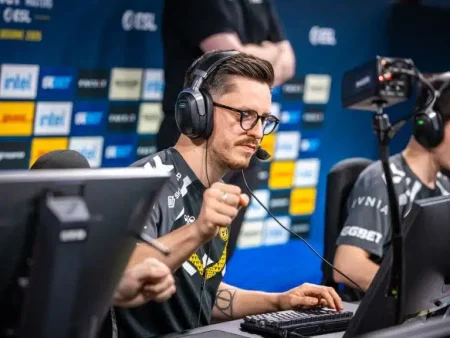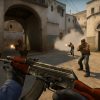Master post-plant positioning in CS2 with this in-depth guide. Learn expert strategies, map-specific tips, team coordination, utility usage, and clutch tactics to win more rounds and dominate your opponents.
Post-plant positioning in Counter-Strike 2 (CS2) refers to how players position themselves after successfully planting the bomb on either bombsite. Once the objective is secured, the game shifts from an aggressive site take to a tactical defense. The T-side’s mission becomes protecting the planted bomb until detonation, while CTs are racing against the clock to defuse. How players position during this phase directly impacts round outcomes—and often, the game itself.
Positioning is more than just hiding behind a box or playing from a corner. It’s a deliberate decision based on angles, sound cues, timing, and team coordination. Every second after the plant requires strategic thinking. Where should you stand? Should you peek? Should you stay silent? Each choice can make the difference between victory and defeat.
In CS2, with its upgraded Source 2 engine and more responsive tick system, every movement and bullet counts more than ever. The refined lighting, audio, and physics make post-plant play both more immersive and more demanding. Players must consider how their bodies and sounds are exposed to new angles, or how utility behaves in tighter or more open site areas.
Positioning effectively post-plant means placing yourself in a spot that:
- Maximizes your chances of defending the bomb.
- Minimizes your risk of being picked off early.
- Takes advantage of sightlines and cover.
- Allows for quick rotations or escape.
Mastering this aspect separates good players from great ones. It’s what turns clutches into highlight reels and lost rounds into heroic comebacks.
Importance of Post-Plant Strategy in Competitive Matches
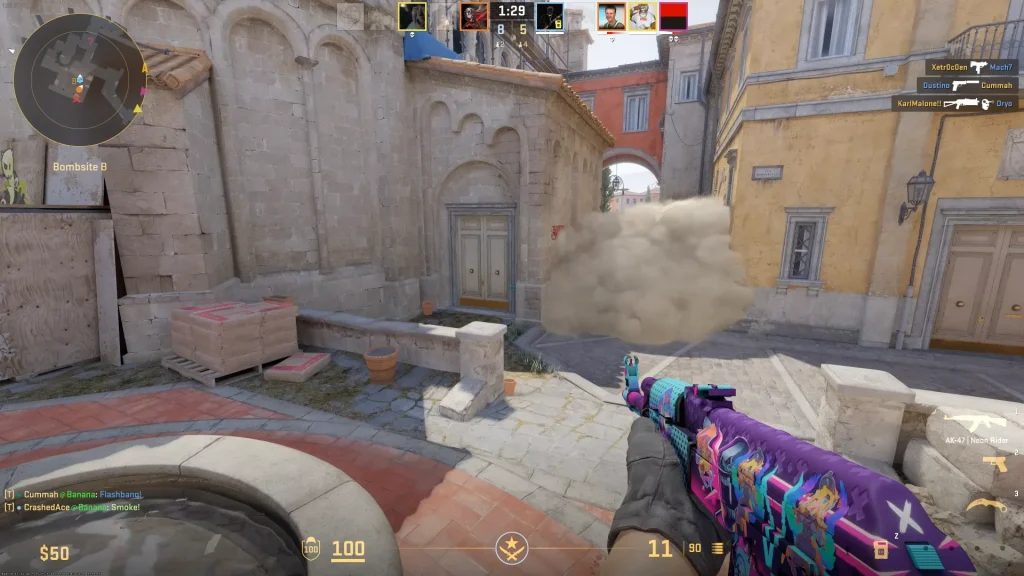
In high-level matches, the post-plant phase is where strategies come to life—or fall apart. Whether it’s a full team surviving the plant or a desperate 1v3 clutch, the decisions made immediately after the bomb is planted often define the round. Even in casual or matchmaking environments, understanding post-plant positioning can significantly boost your win rate.
Why is it so crucial?
- Time is against the CTs: Once the bomb is planted, the pressure is on them. Every second that ticks by increases the T-side’s chances. Proper positioning ensures the defenders can’t easily gain control.
- Control wins rounds: Teams that manage chokepoints and sightlines post-plant essentially “own” the map. Giving up control allows CTs to sneak in and defuse with minimal resistance.
- Utility efficiency: Saving and using utility (smokes, molotovs, flashes) during post-plant can delay retakes and make CTs waste their own nades, time, and positioning.
- Economy impact: Winning or losing post-plant rounds often affects team economy. A failed post-plant can mean an eco round next. Conversely, a successful defense can crush the enemy’s economy.
In a nutshell, perfecting post-plant positioning means you’re not just reacting—you’re proactively winning rounds through intelligence, awareness, and coordination. It’s not about luck; it’s about preparation.
Key Elements of Effective Post-Plant Positioning

Map Awareness and Bomb Plant Locations
Where you plant the bomb plays a massive role in where you should position afterward. Each map has optimal plant spots based on common CT rotations, visibility, and the angles you can hold from a distance.
Let’s break it down:
- Default Plants: These are the standard plant spots you see in most rounds. They’re safe to reach but often offer limited visibility. Great when playing from close.
- Open Plants: Planted in the open for visibility from multiple angles. High risk, high reward. Ideal for long-range defense (e.g., AWP or scout).
- Off-Plants: Hidden or unusual spots meant to throw off CTs or bait defuse attempts. Useful in clutch or gimmick plays.
Knowing the map layout means understanding which post-plant spots give you vision of the bomb. For example:
- On Mirage A, planting for Palace lets an AWPer watch the bomb safely.
- On Inferno B, planting in the open lets a player in Banana or Coffins defend effectively.
A good rule of thumb: always communicate plant location and plan positions around it. Don’t just randomly scatter. Coordinate so that someone has eyes on the bomb while others are in trading or supporting spots.
Understanding Bomb Timer and Economy Pressure
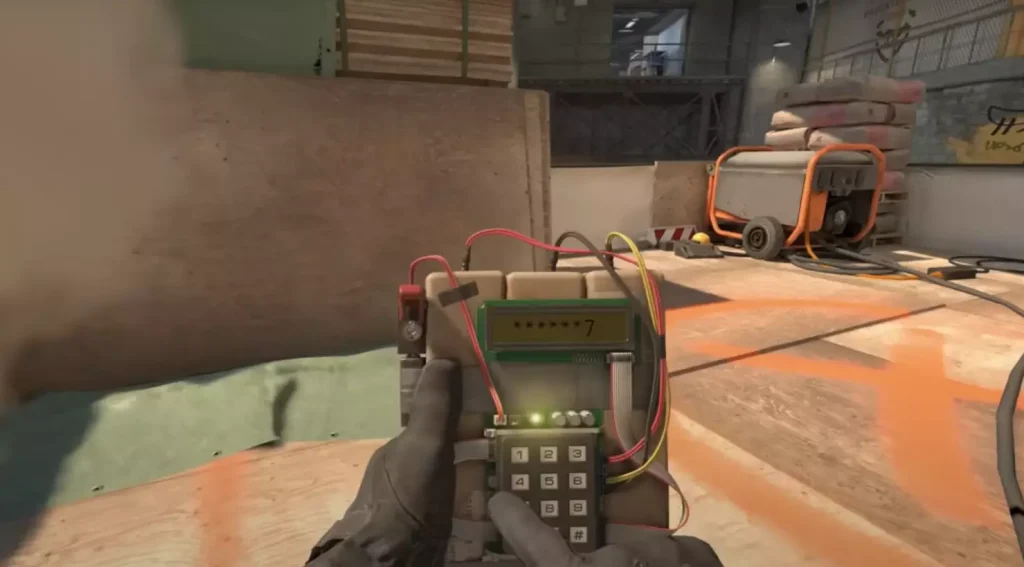
In CS2, the bomb timer is 40 seconds. This countdown adds intense psychological and strategic pressure. Every tick pushes CTs to act faster, and T-side players must balance aggression with patience.
Here’s how the timer should influence your positioning:
- 0–15 Seconds (Early Post-Plant): Prioritize repositioning. Get to your chosen angle, avoid unnecessary fights, and be quiet. CTs may be setting up utility or flanks.
- 15–30 Seconds: This is where retakes usually start. Be ready for action. Hold your crossfires, listen for sound cues, and use utility to delay.
- 30–40 Seconds: If the CTs haven’t started defusing yet, pressure them. Use molotovs, peek if necessary, or bait shots. Time is your ally now.
Also, consider economy. If the CTs are low on funds, they may opt to save instead of pushing a tough retake. Don’t hunt too early—force them to commit or let the bomb do the work.
On the other hand, if your team is broke, surviving the round may be more important than hunting. Preserve weapons, especially AWP or rifles with armor. Smart post-plant positioning can make or break your next buy round.
Common Mistakes Players Make in Post-Plant Situations

Over-Peeking and Losing Man Advantage
One of the deadliest sins in post-plant play? Over-peeking. It’s an ego move that often costs rounds.
Over-peeking means showing yourself to the enemy without a solid reason—no info, no trade potential, no support. Maybe you want to get that flashy kill or confirm info, but without backup, it’s a gamble.
Here’s why it’s dangerous:
- You give the CTs free 1v1 fights.
- You remove your team’s numerical advantage.
- You might lose control of key angles.
Let’s say it’s a 3v2, and you peek CT spawn on Mirage without a flash or teammate. You get dropped. Now it’s 2v2, and the CTs have a better shot. Rinse and repeat, and you’ve thrown the round.
Smart post-plant means playing the clock, not the kill. Only peek if:
- You’re in a trade setup.
- You hear the defuse and want to pressure.
- You have utility to force movement or buy time.
- You know the exact position of the enemy.
Instead of peeking blindly, hold your angle and wait for them to come to you. Let the pressure work in your favor.
Poor Communication and Lack of Coordination
CS2 is a team game, and post-plant rounds are where communication either shines or collapses.
Here’s what bad communication looks like:
- No one calls plant location.
- Two players stack the same angle while the bomb is exposed.
- No one has eyes on the bomb during a defuse.
- Players rotate away without informing teammates.
And the result? Chaos.
To fix this:
- Call out where you’re planting.
- Assign who’s watching what angle.
- Use phrases like “I’ve got bomb from ramp,” or “Watch flank from mid.”
- Make sure at least one player can see or hear the bomb.
- Always remind teammates of the bomb timer and defuse sounds.
Good comms make the post-plant feel like a symphony. Everyone knows their role, watches their angle, and reacts in sync. Bad comms make it a horror show—where the round slips away because nobody said a word.
Post-Plant Strategies Based on Team Roles
Lurkers – Timing the Flank
In the post-plant scenario, a lurker becomes one of the most critical pieces on the board. Their job doesn’t end once the bomb is planted. In fact, a well-timed flank from a lurker can shut down a CT retake before it even starts.
A good lurker doesn’t just hold a random off-angle hoping someone walks into their crosshair. They’re listening for sound cues, watching radar, reading rotations, and striking when it matters most. Their positioning is often in unconventional spots—behind enemy lines or watching flank routes that teammates can’t cover while on-site.
Effective Lurker Post-Plant Tips:
- Don’t rush the flank. If you show yourself too early, the CTs will know and adapt. Let them engage your teammates on-site, then hit them from the back.
- Watch rotations. If the CTs are coming from one side, adjust your timing to ensure you hit them while they’re distracted or exposed.
- Communicate. Call out how many players you hear or see and when you plan to move. This lets your team set up crossfires or delay CTs.
Lurkers like Xyp9x (in his prime) made careers out of clutching rounds by playing post-plant perfectly from off-angles. They understood one golden rule: surprise equals power.
If you’re lurking post-plant, think of yourself as the shadow in the corner. You may not be the star of the show, but when you strike at the right time, you end it.
Entry Fraggers – Early Positioning Post-Plant
The job of the entry fragger is to crack open the bombsite—but once the bomb is down, their positioning still matters immensely. Why? Because they’re often the first player deep into enemy territory and have the chance to set up strong defensive angles.
After the plant, entry fraggers should avoid staying in the open or holding aggressive peeks unless it’s part of a coordinated play. Their post-plant role shifts from “take space” to “hold space.”
Smart Entry Fragger Post-Plant Moves:
- Reposition: Don’t just sit where you killed the first CT. Move to a new angle that can catch them off guard.
- Pair with support: Play close with a teammate so you can swing together. Trading is essential in 2v2 or 3v3 situations.
- Don’t overextend: You did your job getting the bomb down—now protect it. Let the CTs come to you.
Many fraggers make the mistake of thinking they need to keep fighting. But in post-plant, patience is a weapon. You’ve already pushed the tempo; now it’s time to control it.
AWPers – Anchor and Angle Holding
AWPers shine in post-plant situations—when used correctly. A sniper rifle in the right hands can lock down long angles, deny site entry, and pick off defusers with surgical precision.
But CS2’s engine also makes the AWP riskier if you’re caught in close-range fights or off-angles. That’s why post-plant positioning as an AWPer must be strategic, disciplined, and intentional.
AWP Post-Plant Best Practices:
- Hold long sightlines: Don’t post up too close unless forced. Instead, anchor from places like A ramp on Mirage or B long on Dust2 where you can control space.
- Reposition post-kill: After you get one pick, relocate. CTs often pre-fire the same angle twice expecting you to peek again.
- Protect the bomb, not the kills: Your job isn’t to pad the scoreboard—it’s to make sure the CTs never get near the defuse.
If played right, AWPers turn into immovable forces during post-plant defense. But it requires calm nerves, excellent crosshair placement, and good communication. You’re the anchor, not the aggressor.
Best Post-Plant Spots on Popular CS2 Maps
Mirage – A Site & B Site Positioning
A Site Post-Plant Spots:
- Palace – Ideal for long-range play and safe visibility of bomb when planted for it. Especially effective for AWPers or solo clutch plays.
- Tetris – Great for supporting teammates and fast rotations. You can peek jungle and stairs while remaining near cover.
- Ramp – A classic fallback spot. You can hold long angles, delay defuses, and support teammates with utility.
Tips for Mirage A:
- Plant for default or triple if playing standard positions.
- Smoke CT or jungle post-plant to delay and isolate enemies.
- Set up a crossfire between ramp and palace for lethal hold.
B Site Post-Plant Spots:
- Apartments – Safest for defending open bomb plants. AWPers and riflers can delay and deny defuse from here.
- Bench – Close quarters, risky but rewarding for catching enemies off-guard.
- Short – Especially effective if you’ve got mid or catwalk control. Let’s you cut off rotations.
Tips for Mirage B:
- Always call plant location—default, bench, or open.
- Use molotovs to block market or short entry.
- If you’re last alive, bait noise with fakes and reposition quickly.
Mirage offers a playground for post-plant creativity. Learn the angles, communicate well, and the map will reward your strategy.
Inferno – Mastering Pit and Banana Control
A Site Post-Plant Spots:
- Pit – Arguably the most powerful post-plant spot in CS history. Gives full view of site, strong cover, and synergy with teammates on site.
- Graveyard – Sneaky, unexpected, and great for clutch plays.
- Boiler/Apps – Hold for flank or late peeks into site.
Tips for Inferno A:
- If planted default, one player in pit and one on-site can cover every angle.
- Don’t all stack site; spread out for crossfire potential.
- Use molotovs to stop lane or short rushes.
B Site Post-Plant Spots:
- Banana – Essential for delaying retakes. Lets you see site from long range and use utility effectively.
- Coffins – A common post-plant spot, good for AWPers and close-quarters defenders.
- Dark/First Oranges – Risky but great for surprise angles in 1vX situations.
Tips for Inferno B:
- Plant open if teammates are in banana.
- One player should always have a molly to deny defuse.
- Avoid stacking both players behind new box—it’s an easy double kill for CTs.
Inferno rewards those who control choke points. Mastering banana and pit control post-plant gives you the upper hand in nearly every round.
Overpass – Playing Around Site and Bathrooms
A Site Post-Plant Spots:
- Bathrooms – Best for long-range holds and delaying rotates.
- Truck – Close but dangerous if you’re not supported. Good in a numbers advantage.
- Bank – A solid long-angle post, ideal for snipers and utility throwers.
B Site Post-Plant Spots:
- Short Pipe – Great for holding from connector or water.
- Heaven – Must-have angle if you’ve got someone playing above. Ideal for watching site plant.
- Graffiti – Provides partial cover and good view of default plant.
Tips for Overpass:
- Plant for long if you’re playing from bathrooms or bank.
- Smoke CT or heaven after plant to block entry.
- Use flashbangs over walls for quick site re-entry.
Overpass is all about layered defense—angles upon angles. Strong post-plant setups here often feel impenetrable when executed correctly.
Ancient – Leveraging Mid and Temple Control
A Site Post-Plant Spots:
- Temple – Safe and lets you hold angles across multiple entry points.
- Donut – Mid connector with long sightlines. Effective for holding off flanks.
- Main – Good fallback spot if you want to bait defuse attempts.
B Site Post-Plant Spots:
- Ramp – Lets you quickly peek bomb and play off sound cues.
- Cave – Easy to molly defuse or deny entry.
- Back Site – Risky, but if you can isolate fights, you can hold it.
Tips for Ancient:
- Control mid early—this influences every post-plant.
- Don’t underestimate the power of molotovs near donut and temple.
- Use audio cues—Ancient’s echo-heavy design gives away footsteps easily.
Mastering Ancient is all about owning timing. The map’s layout rewards coordinated post-plant play more than almost any other in CS2.
Coordinating with Teammates During Post-Plant
Setting Up Crossfires and Trade Positions
Crossfires are the bread and butter of strong post-plant defense. A well-placed crossfire setup turns two rifles into a fortress. It forces the CTs into impossible choices—peek one player and get shot by the other, or wait and get time-pressured by the bomb timer.
What is a crossfire?
A crossfire is when two or more players watch the same angle or entry from different directions, making it incredibly difficult for opponents to clear one without being exposed to the other.
Why does it matter post-plant?
Because in post-plant, you want to limit 1v1s and force the CTs into situations where they can’t isolate your teammates. Crossfires ensure that if one teammate dies, the other immediately trades.
Examples of great crossfire setups:
- Mirage A Site: One player in Palace, one on Ramp watching the same default plant.
- Inferno A Site: One in Pit, one Site—they cover short and long while protecting each other.
- Overpass B Site: One Water, one Short—forces CTs to clear both sides simultaneously.
Tips for Setting Up Crossfires:
- Communicate your positions. Say, “Hold until I swing” or “Let them walk into me first.”
- Avoid standing too close—spread out enough to watch different angles.
- Don’t double peek unless coordinated. Let the enemy commit before engaging.
Crossfires aren’t just powerful—they’re demoralizing. CTs often get deleted without landing a bullet when executed correctly.
Callouts and Timing Communication
A quiet post-plant is a lost post-plant. Teams that talk and coordinate win. Teams that don’t? They die with nades still in hand and no idea where the enemy came from.
Key Post-Plant Communication Essentials:
- Plant Callout: Always announce where you’re planting (“Planting for ramp,” “Default plant,” “Open for long”).
- Sightlines: Call if you can or can’t see the bomb. (“I’ve got eyes on bomb from apps”).
- Enemy Locations: Use specific, accurate callouts. Not “He’s somewhere CT,” but “One pushing jungle now, with AWP.”
- Utility Usage: Say when and where you’re throwing nades. (“Flashing heaven now,” “Mollying banana, don’t peek”).
- Timing: “10 seconds left,” “Stick close to bomb,” “Wait for tap then peek.”
A team with good comms doesn’t need insane aim—they outplay and out-time their opponents. Good timing makes your plays feel rehearsed, even if they’re improvised.
Don’t leave your teammates guessing. Speak clearly, quickly, and confidently. Because when the clock is ticking, words win rounds.
Utility Usage in Post-Plant Defense
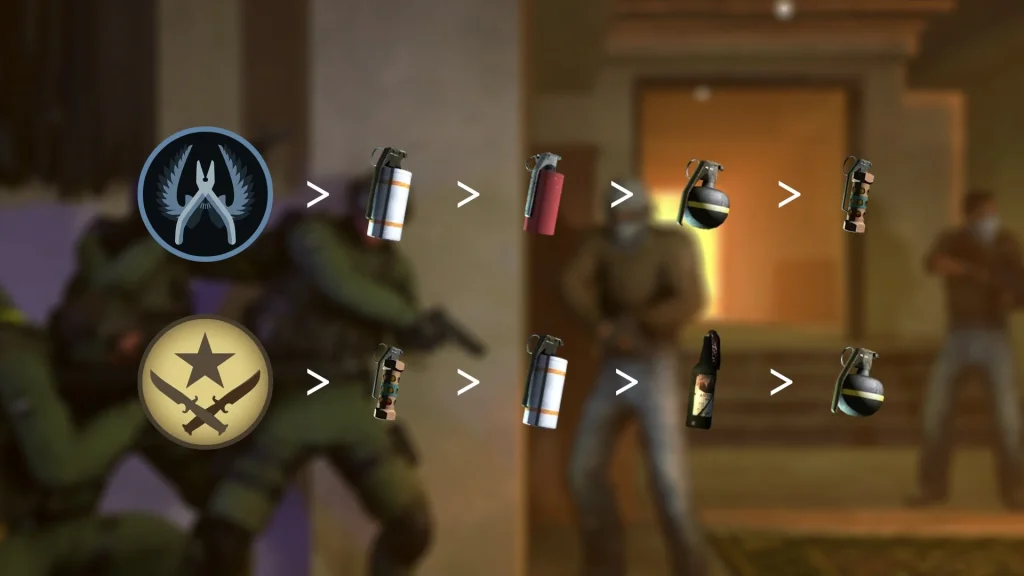
Smokes, Molotovs, and Flashbangs for Site Denial
Utility is your best friend in the post-plant. It helps you delay, deny, distract, and destroy. But if you use it poorly—or too early—you lose its power. Mastering post-plant utility is about timing and intention.
Smokes
- Block sight: Use them to deny vision from CT spawn, heaven, jungle, or other angles.
- Fake presence: Throw a smoke on one side and rotate to another.
- Retake disruption: Late-round smokes force CTs to push blind or wait, costing them time.
Molotovs/Incendiaries
- Deny defuse: The most iconic post-plant use. Throw a molly on the bomb after hearing the tap to buy time.
- Delay rotations: Molly choke points like banana, connector, or heaven to hold off reinforcements.
- Force repositioning: Flush enemies out of corners for easier kills.
Flashbangs
- Defensive flashes: As CTs enter, blind them to delay or peek safely.
- Re-entry flashes: If you’re retaking a site post-plant (like in clutch scenarios), flash to regain control.
- Fake flashes: Throw a flash, then don’t peek—force enemies to turn and waste precious seconds.
Best Practices:
- Time your utility: Don’t throw everything right after the plant. Save it for key moments (like 20-30s on the clock).
- Don’t waste it: If your team’s got 3 molotovs and the bomb is planted, keep one or two for the final 10 seconds.
- Coordinate: Layer utility. One smokes, one mollies, one peeks—it’s unbeatable when done right.
Winning post-plants with utility isn’t flashy—but it’s brutally effective.
Delay Tactics with Utility to Burn the Clock
Delaying is the name of the game in post-plant defense. The more time you waste, the more desperate the CTs become—and desperation leads to mistakes.
Delay Tactics:
- Molotov defuse points: Especially at 30–35 seconds. Even if the CTs get a kill, they still have to wait for the fire to clear.
- Re-smoke CT or short: If you’ve already used a smoke, throw another one at 20 seconds. Layering utility means they’ll have less time to act.
- Fake peeks after flashes: Flash a corner, jiggle peek to bait out utility or shots, then fall back.
Remember: your goal is not to kill. Your goal is to run the clock. If the CTs can’t defuse by 40 seconds, you win—even if you all die.
Sound Cues and Information Gathering
Listening for Defuse Attempts and Footsteps
In CS2, sound is sharper, more directional, and more detailed than ever before. In post-plant, sound is your radar—and if you’re not listening, you’re fighting blind.
Key Sounds to Listen For:
- Defuse Tap: This is your cue. The moment you hear it, respond. Either molly the bomb, flash the site, or peek if it’s safe.
- Footsteps: Each map has signature sound textures. Listen for running up stairs, dropping from heaven, or pushing through water.
- Weapon Switches and Scope-ins: A scoped AWP clicking in heaven or a silencer attaching can give away positions.
Pro Tips:
- Use headphones. Sounds obvious, but stereo audio helps you pinpoint enemy locations like magic.
- Don’t run unnecessarily. If you’re holding an off-angle, walking keeps you hidden.
- Call what you hear. Even “I think I heard one short” is better than silence.
Sound cues let you play smarter, not harder. It’s the closest thing to legal wallhacks CS2 will ever give you—use them.
Using the Radar and Deathcam Information
Beyond sound, the radar is your best visual tool in a post-plant. It tells you where teammates died, where enemies were last seen, and what areas are exposed.
Radar Tips:
- Look for gaps: If no one is watching mid, assume someone’s flanking.
- Watch teammate POVs in deathcam: Even a one-second glance gives you info like “last seen jungle” or “2 pushing banana.”
- Monitor the bomb icon: Know who can see it and who can’t.
CS2’s UI makes information gathering easier than ever—but it still depends on the player. If you’re not glancing at your radar every few seconds, you’re gambling.
Combining sound with radar is like having eyes and ears in every corner. That’s the edge you need to close out rounds.
Adapting Your Post-Plant Strategy Based on Enemy Playstyle
Playing Aggressive vs. Passive Retake Teams
Every team plays differently. Some charge straight in with flashes flying. Others slow-walk and bait utility. Knowing your opponent’s playstyle means you can counter it perfectly.
Against Aggressive CTs:
- Fall back early: Don’t get caught in early trades. Let them push, then collapse with crossfires or utility.
- Use molotovs fast: Aggro teams won’t wait. Burn them before they’re on-site.
- Play from distance: They want brawls—so deny them by playing long angles.
Against Passive CTs:
- Take control: Push into key spots like CT spawn or short. Don’t give them time to group.
- Punish saves: If they’re saving often, hunt them after the round to damage their economy.
- Hold tighter angles: Passive teams won’t dry-peek; they’ll walk into your scopes.
The point is simple: don’t play every post-plant the same way. If the CTs are rushing, adapt. If they’re slow, pressure them. Always be the smarter team.
Recognizing and Exploiting Opponent Patterns
In CS2, patterns are your cheat code. Most teams repeat strategies without realizing it—especially under pressure.
How to Spot Patterns:
- They always retake from CT and jungle on Mirage.
- They never flank banana on Inferno.
- They double push heaven on Overpass.
Once you spot a habit, exploit it. Set up a trap. Hold the angle. Wait for the push. Suddenly, you’re not defending the bomb—you’re hunting.
Pattern recognition is what separates good players from game-changers. Read the playbook, then rewrite it in your favor.
Practicing Post-Plant Scenarios in Training
Using Workshop Maps and Custom Servers
Improving your post-plant skills isn’t just about playing more matches—it’s about deliberate practice. And one of the best ways to do that in CS2 is through workshop maps and custom server routines specifically designed for post-plant drills.
Workshop Maps to Use:
- Yprac Map Series: Offers detailed post-plant training with situational scenarios. These maps let you simulate bomb plants on various sites and test defending from different angles.
- Aim Training Maps: These improve your reaction time and positioning which directly translates into smarter post-plant play.
- Utility Practice Maps: Post-plant rounds often require perfect molotovs or smokes—these maps let you learn every lineup under no pressure.
How to Practice Efficiently:
- Simulate Common Scenarios: Set up a situation where the bomb is planted and practice defending it from your favorite spot.
- Use Bots with Difficulty Settings: Ramp up the pressure by playing against bots that retake quickly.
- Create 2v2 or 3v3 Retake Lobbies with Friends: This mirrors the real post-plant situations you’ll face in ranked or competitive.
Bonus Tip: Record yourself and watch your plays afterward. Were you peeking unnecessarily? Did you hold the right angle? Were you too exposed? That level of self-analysis takes your game to the next level.
Practicing post-plants isn’t just about aim—it’s about decision-making. These maps and setups allow you to hone that decision-making in a controlled environment before bringing it into high-stakes matches.
Watching Demos and Pro Play Analysis
Want to get better at post-plants? Start by studying the best in the game. Watching professional demos offers you a masterclass in patience, coordination, and positional discipline.
How to Watch Demos Effectively:
- Focus on Site Control After the Plant: How do pros position? Where do they hold? How often do they peek?
- Watch Different Roles: See how lurkers, AWPers, and support players behave post-plant.
- Pay Attention to Communication: Use team POVs (available in some matches) to listen in on their callouts and coordination.
Best Sources for Pro Demo Reviews:
- HLTV.org: Download demos from recent tournaments.
- YouTube Analysts (like WarOwl, n0thing, and fl0m): They often break down full rounds, explaining decision-making in simple terms.
- Twitch VODs: Watch pros like s1mple, ZywOo, or ropz in real-time situations.
It’s like watching a chess grandmaster. You might not catch every move immediately, but over time, you’ll absorb the thought process behind greatness.
Psychological Pressure in Post-Plant Situations
Staying Calm and Avoiding Tunnel Vision
Post-plant moments are often the most intense parts of a round. The bomb is ticking. Your hands are sweating. Your heart is pounding. And that’s when most players make mistakes—not because of skill, but pressure.
Common Psychological Mistakes:
- Tunnel Vision: Focusing only on one angle or one threat and missing another.
- Panicking After a Teammate Dies: Breaking setup to try and trade immediately instead of holding steady.
- Second-Guessing Decisions: You rotate, then rotate back, then peek late—and you get punished.
How to Stay Calm Under Pressure:
- Have a Post-Plant Plan Before Planting: Know where you’ll go and what your role is. Don’t make it up on the fly.
- Control Your Breathing: Sounds cheesy, but slowing your breath genuinely helps reduce physical tension.
- Trust Your Setup: If you’re holding the right angle with good crosshair placement, trust it. Let them make the mistake.
The greatest clutches often look effortless—not because they are, but because the player kept their cool when everyone else cracked. Be that player.
Making Smart Decisions Under Pressure
Smart decisions beat quick ones. In post-plant play, the goal isn’t always to kill—it’s to outlast. That means prioritizing positioning, timing, and survival over ego or flashiness.
Make Smart Moves Like:
- Jump-spotting the bomb instead of peeking fully.
- Fake noise, then walk to reposition.
- Letting the defuse start, then throwing a molly rather than exposing yourself.
You can’t control the clock, but you can control how you use it. Smart play = wins.
Post-Plant Positioning for Clutch Scenarios
1vX Situations – Isolating Fights
When you’re the last man standing, and the bomb is planted, the rules change—but the opportunity to win still stands tall. In a 1vX situation, the goal becomes isolate, delay, outplay.
How to Win Clutch Post-Plants:
- Force 1v1s: Don’t let enemies trade you. Take a fight, reposition, and take another.
- Use the Bomb as Bait: Peek only after you hear the defuse sound.
- Avoid Predictable Spots: Don’t hide in the corner everyone clears first. Think like your enemy.
You want them hunting shadows while the bomb ticks. Make them second-guess every step. A well-played 1vX clutch post-plant is as much psychological warfare as mechanical skill.
Bomb Sound Baits and Fake Taps
Fake defuses (or “fake taps”) are CTs’ main tactic to bait out the last player. The best clutch players know how to sniff out the fake from the real.
How to Read the Fake:
- If there’s too much time, it’s usually a bait.
- If there are two CTs, one might bait while the other holds the angle—watch for this.
- Time your peek—let a second pass before checking, or molly and force the truth.
You can use the bomb sound as your trigger. Wait for it, react to it, and let CTs make the first move. The longer the clock ticks, the more powerful your position becomes.
Pro-Level Examples of Perfect Post-Plant Execution
Iconic Post-Plant Rounds in CS2 Esports
There have already been numerous clutch post-plant scenarios in CS2’s short pro history that showcase the beauty of positioning and timing.
Examples:
- s1mple’s 1v3 on Overpass: Using utility to fake rotations, holding heaven with an AWP, and then tapping the defuser just before detonation.
- ZywOo’s Mirage Post-Plant Hold: Solo holding from palace with perfect audio cues and pre-aimed angles.
- Ropz 1v2 on Ancient: Using timing and misdirection to throw off CTs while burning 10+ seconds with just movement.
These moments aren’t just flashy—they’re instructional. You learn how spacing, utility, and patience turn post-plants into masterpieces.
What We Can Learn from Pro Players
- Positioning Over Aim: Pros often win not because they out-aim, but because they out-position.
- Perfect Utility Timing: Holding molotovs until the final 5 seconds. Smokes to stall. Flashes for info.
- Team Discipline: Rarely do you see two pros double-peeking an angle unless it’s coordinated. That control wins games.
Study the pros. Steal their strats. Adapt them for your own games.
Conclusion
Post-plant positioning in CS2 is a science, an art, and a psychological battle. It’s where rounds are won or lost. Whether you’re holding from afar with an AWP, hiding in a corner waiting for the perfect swing, or coordinating a 3-man crossfire, your decisions after the bomb goes down matter more than most players realize.
The best post-plant players don’t just rely on good aim—they master timing, information, communication, and map knowledge. They understand when to be aggressive, when to hold, and when to let the clock do the killing.
So the next time you hear “bomb has been planted,” don’t just hide. Think. Coordinate. Position. And win.
FAQs
What is the best post-plant spot in Mirage A site?
The best spot depends on your team’s position, but Palace and Ramp are top-tier. They offer long angles and cover while giving you visual access to the bomb planted default.
How do I stop over-peeking after the bomb plant?
Stay disciplined. Only peek if you’re in a tradeable position or hear a defuse. Play the clock, not your ego.
Should I save utility for post-plant or use it to enter the site?
If you have teammates alive, save at least one smoke or molly. A well-timed molotov can win a round by itself.
How can I practice post-plant scenarios effectively?
Use Yprac or custom training maps, simulate different bombsite situations, and play 2v2 retake practice with friends. Also, study demos from pro matches.
What’s the ideal team communication after a plant?
Communicate plant location, assign who’s watching which angle, announce utility use, and provide enemy movement updates. Clarity and calm win rounds.
